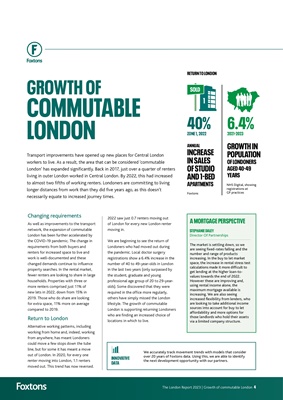
1
SOLD
GROWTH OF
COMMUTABLE
LONDON
Transport improvements have opened up new places for Central London
workers to live. As a result, the area that can be considered 'commutable
London' has expanded significantly. Back in 2017, just over a quarter of renters
living in outer London worked in Central London. By 2022, this had increased
to almost two fifths of working renters. Londoners are committing to living
longer distances from work than they did five years ago, as this doesn't
necessarily equate to increased journey times.
A MORTGAGE PERSPECTIVE
40% 6.4%ZONE 1, 2022 2021-2023
ANNUAL
INCREASE
IN SALES
OF STUDIO
AND 1-BED
APARTMENTS
GROWTH IN
POPULATION
OF LONDONERS
AGED 40-49
YEARS
Foxtons
NHS Digital, showing
registrations at
GP practices
Changing requirements
As well as improvements to the transport
network, the expansion of commutable
London has been further accelerated by
the COVID-19 pandemic. The change in
requirements from both buyers and
renters for increased space to live and
work is well-documented and these
changed demands continue to influence
property searches. In the rental market,
fewer renters are looking to share in large
households. Properties with three or
more renters comprised just 11% of
new lets in 2022, down from 15% in
2019. Those who do share are looking
for extra space, 11% more on average
compared to 2019.
Return to London
Alternative working patterns, including
working from home and, indeed, working
from anywhere, has meant Londoners
could move a few stops down the tube
line, but for some it has meant a move
out of London. In 2020, for every one
renter moving into London, 1.1 renters
moved out. This trend has now reversed.
2022 saw just 0.7 renters moving out
of London for every new London renter
moving in.
We are beginning to see the return of
Londoners who had moved out during
the pandemic. Local doctor surgery
registrations show a 6.4% increase in the
number of 40 to 49-year-olds in London
in the last two years (only surpassed by
the student, graduate and young
professional age group of 20 to 29-yearolds).
Some discovered that they were
required in the office more regularly,
others have simply missed the London
lifestyle. The growth of commutable
London is supporting returning Londoners
who are finding an increased choice of
locations in which to live.
RETURN TO LONDON
The market is settling down, so we
are seeing fixed-rates falling and the
number and range of products
increasing. In the buy to let market
space, the increase in rental stress test
calculations made it more difficult to
get lending at the higher loan-tovalues
towards the end of 2022.
However these are improving and,
using rental income alone, the
maximum mortgage available is
increasing. We are also seeing
increased flexibility from lenders, who
are looking to take additional income
sources into account for buy to let
affordability and more options for
those landlords who hold their assets
via a limited company structure.
We accurately track movement trends with models that consider
over 20 years of Foxtons data. Using this, we are able to identify
the next development opportunity with our partners.
INNOVATIVE
DATA
The London Report 2023 | Growth of commutable London 4
STEPHANIE DALEY
Director Of Partnerships